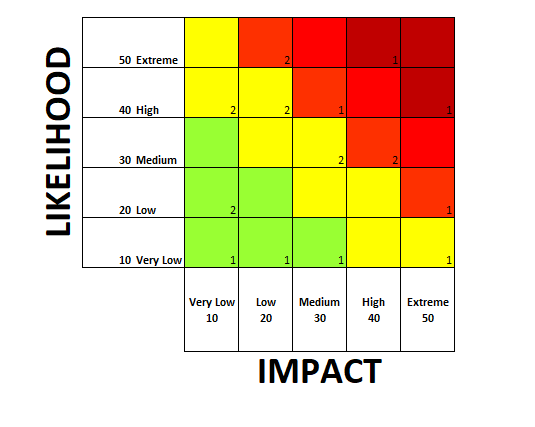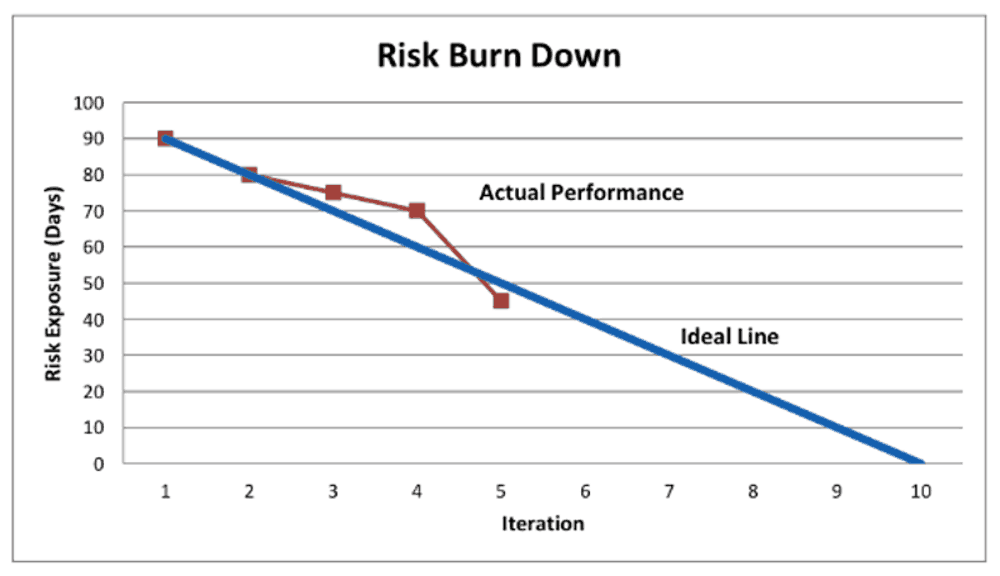A quick recap of risk management
According to the Project Management Institute (PMI), a risk is an uncertain event or condition that, if it occurs, can have a positive or negative effect on one or more project objectives.
- The first step in risk management is the preperation and the continuous grooming of the risk register, which captures all probable risks that can happen during the project
- Once the risk register is prepared, the logical step is to allocate probability of occurrence (likelihood) and impact for every risk item. Organizations may define their own scales for probabilities and impacts. This step is known as qualitative risk analysis
- Multiply Probability rating with Impact Rating to arrive at the risk score. Risk score = Probability x Impact
- Prioritize the risk register based on the ‘Risk Score’
- Organizations / Project teams can define their ‘Risk threshholds’
- Risks with high risk scores ungergoes quatitative risk analysis (Simulation, Decision trees, Montecarlo analysis )
- For the shortlisted risks, risk response actions and contingency actions are defined
- Response actions are implemented and monitored
- In case the risks occur, then contingency actions are triggered.
Risk rating matrix

Risk burndown chart

Risk monitoring & controlling is a critical aspect of risk management in project management. It involves tracking identified risks, assessing their status, and implementing appropriate responses to mitigate their impact on project objectives. Here are some common tools and techniques used for risk monitoring:
- Risk Registers: Risk registers serve as a central repository for documenting and tracking all identified risks throughout the project lifecycle. They typically include information such as the risk description, likelihood, impact, status, mitigation strategies, and assigned owners. Regularly update the risk register to reflect changes in risk status and mitigation activities.
- Risk Reviews and Assessments: Conduct regular reviews and assessments of identified risks to evaluate their status, likelihood, and potential impact on project objectives. Use qualitative assessments (e.g., risk probability and impact assessment) and quantitative analysis (e.g., Monte Carlo simulation) to assess risk severity and prioritize mitigation efforts.
- Risk Reporting: Generate regular risk reports to communicate the status of risks to project stakeholders. Risk reports should provide an overview of identified risks, their current status, any changes or updates, and the effectiveness of risk responses. Tailor risk reports to the needs of different stakeholders and ensure they are timely and accurate.
- Risk Dashboards: Utilize risk dashboards to visually represent key risk metrics and indicators, such as risk exposure, trends, and heat maps. Risk dashboards provide stakeholders with a clear and concise overview of the project’s risk profile and enable quick decision-making. Customize risk dashboards to highlight critical risks and emerging threats.
- Risk Workshops: Conduct risk workshops or brainstorming sessions with project team members and stakeholders to identify, analyze, and prioritize risks. Risk workshops facilitate collaboration, foster risk awareness, and generate insights into potential threats and opportunities. Use facilitated techniques such as SWOT analysis, scenario planning, or the Delphi method to uncover hidden risks.
- Key Risk Indicators (KRIs): Define and monitor key risk indicators (KRIs) to track trends and early warning signs of emerging risks. KRIs are quantitative or qualitative metrics that provide insight into the likelihood and impact of risks on project objectives. Establish thresholds or triggers for KRIs to signal when proactive risk response actions are required.
- Risk Triggers: Establish risk triggers or thresholds that indicate when a risk response or contingency plan should be activated. Risk triggers help project teams proactively monitor risks and take timely action to mitigate their impact. Monitor risk triggers closely and implement predefined response actions when triggered.
- Risk Audits: Conduct periodic risk audits to assess the effectiveness of risk management processes and controls. Risk audits evaluate whether risk management activities are being implemented as planned and identify opportunities for improvement. Engage internal or external auditors to provide an independent review of risk management practices and identify areas for enhancement.
- Continuous Risk Monitoring: Implement a process for continuous risk monitoring throughout the project lifecycle. Regularly review and update the risk register, assess new risks, reassess existing risks, and adapt risk management strategies as needed to ensure project success. Encourage a culture of risk awareness and proactive risk management among project team members.
By using these tools and techniques for risk monitoring, project managers can effectively track and manage identified risks, mitigate potential threats, and capitalize on opportunities to enhance project outcomes.
Risk mitigation
Risk mitigation involves taking proactive steps to reduce the likelihood or impact of identified risks on project objectives. Here are some strategies commonly used for risk mitigation:
- Risk Avoidance: Avoiding risk involves eliminating the risk altogether by changing project plans or avoiding certain activities or situations that pose a high risk. This strategy is most effective for risks with severe consequences or those that are easily avoidable.
- Risk Transfer: Risk transfer involves shifting the responsibility for managing a risk to another party, such as an insurance provider or subcontractor. Examples include purchasing insurance to cover potential losses or outsourcing high-risk activities to third-party vendors.
- Risk Reduction: Risk reduction involves taking actions to decrease the likelihood or impact of a risk. This may include implementing preventive measures, improving processes or systems, enhancing controls, or using redundant resources. Risk reduction strategies aim to minimize the severity of potential risks while still allowing the project to proceed.
- Contingency Planning: Contingency planning involves developing backup plans or alternative strategies to address potential risks if they occur. This may include creating contingency reserves, establishing fallback options, or developing emergency response plans. Contingency planning helps ensure that the project can respond effectively to unforeseen events without significant disruption.
- Risk Sharing: Risk sharing involves collaborating with stakeholders or partners to jointly manage risks and share the associated costs and benefits. This may include forming risk-sharing agreements, joint ventures, or partnerships where risks and rewards are shared among parties. Risk sharing can help distribute risk more evenly and reduce the impact on individual project participants.
- Early Warning Systems: Implementing early warning systems allows project teams to detect potential risks early on and take proactive measures to mitigate their impact. This may involve setting up monitoring mechanisms, using key risk indicators (KRIs), conducting regular risk assessments, or implementing alert systems to signal when risks exceed predefined thresholds.
- Continuous Improvement: Continuous improvement involves systematically identifying, analyzing, and addressing risks throughout the project lifecycle. This may include conducting lessons learned sessions, implementing feedback mechanisms, and integrating risk management into project management processes. By continuously improving risk management practices, project teams can enhance their ability to identify, assess, and mitigate risks effectively.
- Risk Communication and Stakeholder Engagement: Effective risk communication and stakeholder engagement are critical for managing risks successfully. Engage stakeholders early and often to identify risks, communicate risk information transparently, and solicit input on risk response strategies. By involving stakeholders in the risk management process, project teams can gain valuable insights and support for risk mitigation efforts.
- Scenario Planning: Scenario planning involves developing multiple plausible scenarios or future outcomes and identifying potential risks associated with each scenario. By anticipating different possibilities and their corresponding risks, project teams can develop flexible plans and response strategies to adapt to changing circumstances.
- Risk Training and Education: Providing risk training and education to project team members and stakeholders helps build awareness, knowledge, and skills in risk management. Offer training sessions, workshops, or seminars on risk identification, assessment, and mitigation techniques to empower individuals to contribute effectively to risk management efforts.
By implementing these risk mitigation strategies, project managers can proactively manage risks and minimize their impact on project objectives, ultimately increasing the likelihood of project success.
